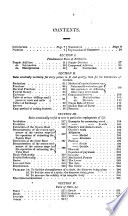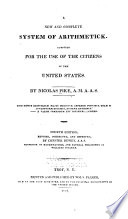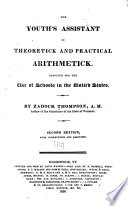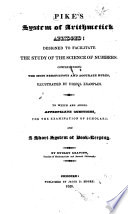 | Nathan Daboll - Arithmetic - 1818 - 246 pages
...equiva^ lent fractious having a common denominator. RULE I. I . Reduce all fractions to simple terms. 2. Multiply each numerator into all the denominators except its own, for a new numerator ; and all the denominators into each other continually for a common denom* inator ; this written under the several... | |
 | Arithmetic - 1818 - 264 pages
...equivalent fractions, having a common denominator, RULE. 1 Reduce all fractions to simple terms. 2. Multiply each numerator into all the denominators, except its own, for a new numerator ; and all the denominators together, for a common denominator, which written under the several numerators, will... | |
 | Daniel Adams - Arithmetic - 1819 - 236 pages
...(or improper) fraction. VI. To reduce, fractions of different denominations to equivalent fraction} having a common denominator. RULE. I Multiply each numerator into all the denominator*, except its own, for \ a new numerator, and all the denominators into each other, continually,... | |
 | Daniel Adams - Arithmetic - 1820 - 260 pages
...reduce fractions of different denominations to equivalent fractions having a common denominator. RULE. Multiply each numerator into all the denominators, except its own, for a new numerator, and all the denominators into each other, continually, for a common denominator. * Any whole number may be... | |
 | Thomas Keith - Arithmetic - 1822 - 354 pages
...complex or compound fractions, they must be reduced to their proper terms by the preceding rules. Then, Rule I. Multiply each numerator into all the denominators, except its own, for a new numerator, and all the denominators together for a common denominator. OR II. 1. Multiply all the denominators of the... | |
 | Beriah Stevens - Arithmetic - 1822 - 436 pages
...fractions of different denominations to equivalent fractions, ha• ving a comm-in denominator. R:7LE. Multiply each numerator into all the denominators, except its own, for a new numerator, and all the denominators into each other, continually for a common denominator. EXAMPLES. s 1. Reduce f, f... | |
 | Nicolas Pike - Arithmetic - 1822 - 536 pages
...fraction. Ana. ^ ; - l.' , CASE. VI. To reduce fractions of different denominators to equivalent fradi&u having a common denominator. RULE I.* Multiply each numerator into all the denominators except it* iivn, fur a new numerator, and all the denominators into each oth'•r, continually, for a common... | |
 | James Mitchell - Mathematics - 1823 - 666 pages
...reduce fractions, having different denominators, to a common denominator. Multiply each numerator by all the denominators, except its own, for a new numerator ; and all the denominators together lor the common denominator; or Hind the least com* mon multiple of all the... | |
 | Zadock Thompson - Arithmetic - 1826 - 176 pages
...reduce fractions of different denominators to equivalent fractions having a common denominator. RULE.! Multiply each numerator into all the denominators except its own for a new numerator, and all the denominators together for a common denominator. Examples. 1. Reduce J, ^ and f to a common denominator.... | |
 | Nicolas Pike, Dudley Leavitt - Arithmetic - 1826 - 214 pages
...fractions of different denominators to equivalent fractions, having a common denominator. RULE. — Multiply each numerator into all the denominators, except its own, for a new numerator, and all the denominators into each other continually, for a common denominator. EXAMPLES. 1. Reduce J, f, and... | |
| |